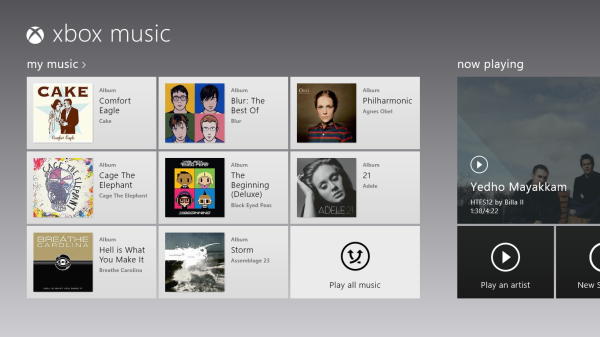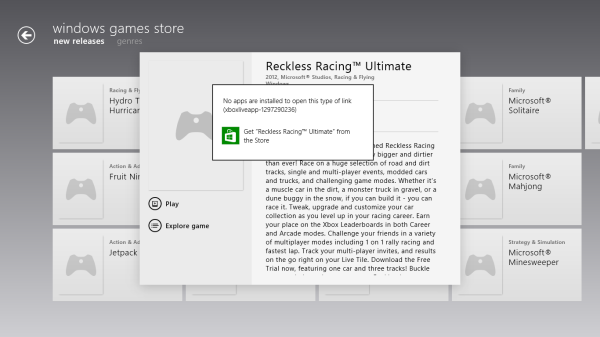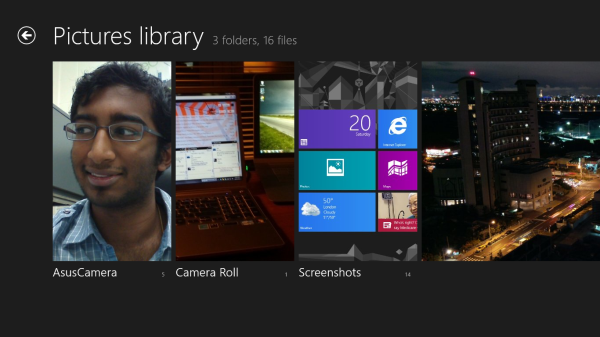The Windows RT Review
by Vivek Gowri & Anand Lal Shimpi on October 25, 2012 12:00 PM EST- Posted in
- Windows RT
- Operating Systems
- Microsoft
- Mobile
- Windows 8
- Tablets
Xbox Live: Music, Video, and Gaming
The music and video players are now part of the Xbox Live family of services, so they’re connected to Xbox Music and Xbox Video respectively. The applications are separate but are very similarly designed and laid out, with local content on the left, featured content in a central location, and content stores to the right. The bottom edge swipe brings up the ability to specify a file for playback, as well as a now-playing control bar. The music application looks quite good when snapped to the edge, with various album art from your library appearing as the background for the music controls.
Hilariously, videos can also be played back when snapped, albeit in a very small window. It’s not the best way to watch a video (who enjoys watching video content in a 320x180 window? Anyone? No takers?) but you can do it if you really want to. The video playback controls are pretty elegant in full-screen mode, and both players seem to have taken a number of interface design cues from the Zune software. I’m a huge fan of the Zune desktop software and how elegantly it operates, so I think this is great. I’m also just glad to not have to deal with Windows Media Player.
Both Xbox Music and Xbox Video look very similar to the latest Xbox dashboard update, and it’s clear that Microsoft is pushing a unified entertainment content front here. I remember when Microsoft was supporting a half dozen different music stores when the original Zune launched in 2006, so I’m just glad that they’re finally consolidating all of their services and concentrating on a single content store. Xbox has been their most successful entertainment effort to date, so it’s no surprise to see Microsoft put their faith in it for media as well.
Now, we can’t discuss Xbox without touching on gaming. Xbox Live is obviously the gaming portal of choice for Windows RT, and offers various hubs for Windows and Xbox 360 games. The Xbox Live application didn’t appear to be ready at the time of posting, with broken links and missing pictures for all the games and hubs. This is still an unreleased software (until Friday, anyways) so it’s possible that we’ll see the application be updated between now and then for a working final release. We will also have to wait until then to see what game support will be like out of the box; currently, the Xbox Windows Game store shows titles like Reckless Racing, Hydro Thunder Hurricane, Fruit Ninja, Cut the Rope, and a number of Microsoft classic titles like Minesweeper and Solitaire, amongst others.
Camera and Photos
The camera application is about as basic as you can get, with a translucent control bar that lets you switch cameras, change between still and video capture modes, set up a timer, and basic picture quality settings. Basic isn’t necessarily a bad thing though, as the application operates smoothly and quickly, with near-instant switching between modes and cameras. The controls are very straightforward - tap and hold to lock exposure is supported, and to capture an image you can just tap anywhere on the screen. It’s one of the easiest capture mechanisms out there, and fits right in with the simple UI.
The photo application pulls images from your local pictures folder and camera roll, as well as being able to connect to Facebook, Flickr, and SkyDrive. They show up as panels for each service, which show a full list of thumbnails. It’s worth pointing out that you can only see photos uploaded to Facebook from your own account, not friend’s images or pictures you’ve been tagged in. As is now the norm with tablet picture galleries, you can view images in slideshow form or just flick through them individually. For local images, the bottom edge swipe brings up an option to delete the images, as well as setting as the lockscreen image and starting a slideshow. For images on Facebook, there’s an option to view them in Facebook, though you need to actually be signed into Facebook in IE for this to work.
The overall takeaway from the camera and gallery applications is that they’re designed as minimally as possible and do exactly what they’re supposed to with a minimum of fuss. You won’t see any spectacular functionality, though the ability to slideshow through Facebook galleries is a nice touch. I think we’ll see manufacturers offer their own spin on these applications, like ASUS and their separate camera application, in an attempt to gain minor levels of platform differentiation. Microsoft has kept a pretty tight reign on the customizations allowed for the Windows Phone platform though, so I can’t see them allowing anything too invasive on Windows RT devices either.















233 Comments
View All Comments
tipoo - Friday, October 26, 2012 - link
I'd like to know that as well. But if it kills even my Core 2 Duo, I don't expect current ARM chips to fare well with that many tabs, but I'd still like to know how it handles background tab loading.Mahadragon - Friday, October 26, 2012 - link
Thanks Anand for the best review of RT I've seen yet. Gives me better idea of what's to come, however it doesn't address the question should I buy Win8 for desktop? The upgrade offer ($40) is out now but I don't seen compelling reason to buy it. You mentioned in your review that Apple has their desktop computer and mobile offerings separate, but the way Win8 is being implemented it sounds like maybe they should have kept it that way.In your review you said it was jarring how it would revert back to the desktop environment when you touched on a desktop app. It's comments like this that make me wonder why upgrade from Win 7? Are the apps that will eventually come to the desktop be all that useful? I suppose if there were a handy Calendar App that could auto-sync with my mobile device that would be nice, but there are already many apps (like Google Calendar) that I can already use to sync between mobile devices.
Your review has given a great many reasons to purchase a Surface tablet, but that's not the decision many of us are facing right now. $500 is not chump change and that doesn't even include the keyboard which is another $100. I just bought a new iPod Touch and will be using that for mobile computing since my Windows Phone 7 device is not nearly as user friendly.
I think MSFT could have kept Win8 same as Win7 with an option to run ARM apps built-in. I think this would have made more sense since they don't have too many apps to begin with. Also, I don't think these little apps, which are optimized for tablet, will necessarily give a great experience on a desktop monitor that you won't be touching.
It almost seems like MSFT is trying to encourage people to buy the tablet by frustrating them with a rough desktop experience and making it smooth on the Surface. Thank you for going over the history of MSFT's initial forays into the tablet space. It's something very few people realize. Yes, MSFT, always the innovator was the first to come out with a tablet over 10 years ago, but nobody even knew about it.
Fortunately for MSFT, there is a god (or rather, Apple) who has always been there to show them the light. Apple: "Use a touchscreen, not a stylus!" MSFT: "Ok, sorry, we thought everyone would cherish the thought of using a digital pen to interact with their tablets. Apple: "Make an App Store and sell software programs through it so people can add functionality to their devices!" MSFT: "Ok, that's a great idea, wish we thought of that." Apple: "Add a camera! People like to take photos." MSFT: "Done." Apple: "Come out with your own retail stores so you can sell to people directly!" MSFT: "Ok, we can do that." Apple: "Always remember to copy us verbatim but not too much. We don't want to have to sue you (again)." MSFT: "Ok, we'll make our products geeky instead of dead sexy how about that?"
yyrkoon - Sunday, October 28, 2012 - link
If you're already using Windows 7, chances are pretty good that you'd just be wasting money.Windows 8 obviously was made for mobile devices. Then perhaps it will perform somewhat faster on the same hardware. But if you're looking for better gaming performance you probably will not see much of a difference there.
The app store is a terrible idea in its current incarnation. I do not know many ( any ) software developers who would be happy about paying a 30% forced fee for any software platform. These same developers who draw users en mass to an operating system by creating many, useful applications. Or, I should say *did*.
Dorek - Friday, November 2, 2012 - link
"Apple: "Add a camera! People like to take photos.""Uh, the Surface doesn't have a rear camera. Rear cameras on tablets are freaking stupid.
Anyway, if you care about such things, Windows 8 has much faster performance than Windows 7. Well worth $40 bucks to me.
shermanx - Friday, October 26, 2012 - link
where's the Wacom digitizer/pen/stylus? while so many tablets are trying to be different from others, I am surprised how few have included a functional pen for taking notes. that is really important feature for education business, and there's nothing that's really working well now. I just need Wacom Bamboo level of experience with a screen on it at a reasonable price.darkcrayon - Saturday, October 27, 2012 - link
There will be a digitizer on the Surface Pro, though I think the pro will be even more of a different market than the RT, considering it will be even larger and heavier.yyrkoon - Friday, October 26, 2012 - link
"The only applications that are allowed to run in desktop mode under Windows RT are Explorer, IE10, Office 2013 and the command prompt "This will either make or break Windows RT. Also, I bet this is a form of DRM imposed by Microsoft. While not DRM per se, they get to say which application we can install on our systems. Good, or bad ? I really do not know. It really depends on how they implement their online store. As I have not used windows 8, or Win RT. However, if it is similar to the google app store. Developers are required to pay an annual $25 USD fee. Which if you ask me, is slightly detrimental to the given community. In that people will be more inclined to charge for their applications, instead of providing FOSS( free open source software ). $25 USD though, really is not all that much.
One thing I can say however. Is that Microsoft sure is pushing their latest mobile software development kits through their mailing lists. Good or bad ? Again, I do not know. I am currently with android development, and unless I see something inspirational from Microsoft. That will likely not change soon. If ever. That is, for mobile devices. On the desktop I still prefer to develop with / on Windows using the .NET base class library.
yyrkoon - Friday, October 26, 2012 - link
Also Anand,I really do not think third party apps will be a problem. At least where the browser applications are concerned. With all the javascript libraries that abound now days, coupled with HTML5 and CSS3. "Offline webapps" will be easy to make, and provide a lot of possibilities. These apps, should work the same on any OS.
Native apps . . .is where Microsoft excels on the desktop At least from a developers standpoint. The .NET base class library takes a lot of work out of software development, and provides many, many useful classes. How this works, or will work cross platform from x86 to ARM I am not exactly sure. But I suspect Microsoft has it covered. As always. Having done a lot of research lately on mobile device development, I know that Microsoft is providing a lot of software development kits. Some that look extremely attractive at first look.
From a software developers standpoint. Windows 8 / Windows RT looks really attractive right now. Since the market is virtually wide open for software developers to make themselves a name.
Now do keep in mind that everything mentioned above is from a developers mindset. As a user . . . yours truly really likes to keep as much freedom as possible. How that works out again is based on how Microsoft implements their app store. Also, if Microsoft can somehow remove the mobile device from the stigma of being a toy. I think they'll have it nailed. We know the OS polish is going to be there for anything Windows lately. So it basically boils down to ( again ) good software availability.
yyrkoon - Saturday, October 27, 2012 - link
Yeah, disregard what I said above.According to what I have just read. Microsoft wants a 30% fee for using their app store. From the developer . . . so yeah Microsoft can kiss my ass as far as Windows RT is concerned.
If they keep on like this, personally I do not care how much work the .NET framework saves me. I will move to another platform and write off their operating systems al together. And I know im not alone.
~joe - Saturday, October 27, 2012 - link
I have one question to anybody owning Windows RT device (particualry Surface). I'm writting from Poland, and so far there is no plans for selling this device here. So I want to buy my in USA. My intention of use is 70% content consumption and 30% content creation using Office. But I need for my work Polish language. The question is - can I switch language to Polish (or ownload Polish language pack)?